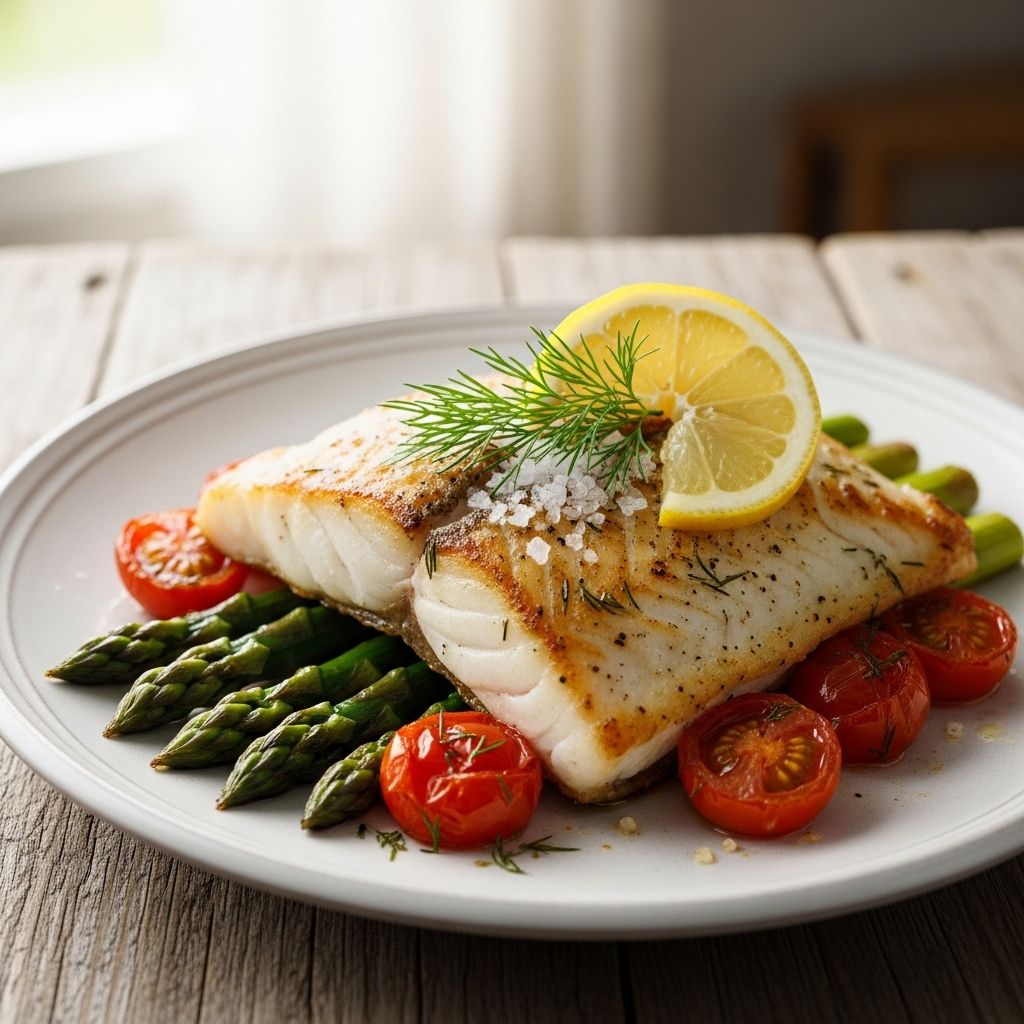Baked Flounder Recipe: Quick, Healthy, Deliciously Flaky Fish
Discover a simple, fuss-free oven-baked flounder recipe with minimal ingredients, easy prep, and unbelievably tasty results.

Image: HearthJunction Design Team
Easy & Excellent Baked Flounder
Looking for a healthy and delicious dinner that requires minimal effort? This easy and excellent baked flounder is the answer. With only a handful of pantry staples, zero chopping, and barely any cleanup, you can enjoy tender fillets bursting with flavor in well under half an hour. Perfect for busy weeknights or whenever you want a light, satisfying meal without the hassle.
Why You’ll Love This Recipe
- Quick & Easy: Prep takes just minutes. No complicated steps or special tools needed.
- Minimal Ingredients: Uses simple pantry staples—no need for a grocery run.
- Healthy: Flounder is naturally low in calories and fat, and baking requires little added oil.
- Delicious Taste: Each bite is flaky, buttery, and infused with bright lemon flavors.
- Easy Cleanup: Baking in one dish means less mess in your kitchen.
Ingredients for Easy Baked Flounder
Here’s what you’ll need for this effortlessly tasty baked flounder dish:
- Flounder Fillets: Fresh or thawed from frozen; thin, delicate, and mild in flavor.
- Butter: Melted, for rich flavor and a slight golden finish.
- Lemon Juice: Freshly squeezed or bottled—adds brightness and balances the buttery richness.
- Salt and Pepper: To season simply, allowing the fish’s subtle flavor to shine.
- Optional Garnishes: Fresh herbs like parsley, dill, or a sprinkle of paprika for color.
| Ingredient | Quantity | Notes |
|---|---|---|
| Flounder fillets | 1 lb (about 4 fillets) | Fresh or thawed; other thin white fish can substitute |
| Butter | 2 tablespoons | Melted |
| Lemon juice | 2 tablespoons | Fresh preferred |
| Salt | 1/2 teaspoon | To taste |
| Black pepper | 1/4 teaspoon | To taste |
| Parsley or dill | Optional | For garnish |
Step-by-Step Instructions
Follow these simple steps for perfect baked flounder every time:
- Preheat your oven to 350°F (175°C). Grease a shallow baking dish lightly with butter or nonstick spray.
- Arrange the fillets in a single layer in the prepared baking dish. Avoid overlapping so the fish cooks evenly.
- Drizzle melted butter evenly over the fillets.
- Squeeze or pour lemon juice over the fish for a burst of citrus flavor.
- Season with salt and pepper to your preference. For a dash of color, sprinkle a little paprika or freshly chopped herbs over the top.
- Bake for 15–20 minutes, depending on thickness, or until the fillets easily flake with a fork and are opaque throughout.
- Serve immediately, garnished with parsley, dill, or extra lemon wedges on the side.
Tips for Best Results
- Use fresh fish: If possible, choose fresh fillets for the best flavor and texture. Thaw frozen fillets completely and pat dry.
- Thin fillets cook quickly: Flounder fillets are delicate, so monitor closely to prevent overcooking.
- Customize the seasoning: Add a pinch of garlic powder, a dash of Old Bay, or a sprinkle of grated Parmesan for extra flavor.
- Line your dish: For even easier cleanup, line the baking dish with parchment paper or foil.
Serving Suggestions
This light, buttery baked flounder pairs beautifully with a variety of side dishes. Try serving it with:
- Steamed or roasted asparagus
- Herbed rice pilaf or quinoa
- A crisp green salad tossed with vinaigrette
- Garlic sautéed spinach or green beans
- Oven-roasted potatoes or sweet potato fries
For a fresh finish, add extra lemon wedges or a sprinkle of fresh dill just before serving.
Recipe Variations
This straightforward baked flounder recipe is endlessly adaptable. Try these tasty twists:
- Panko & Parmesan Crust: Top fillets with a mixture of panko breadcrumbs, Parmigiano-Reggiano, and melted butter for crunch and savory depth.
- Mediterranean Style: Add a topping of chopped tomatoes, fresh basil, and a drizzle of olive oil before baking.
- Spicy Cajun: Dust the fillets with Cajun or Creole seasoning for bold, zesty flavor.
- Herb-Crusted: Mix chopped fresh herbs like parsley, chives, and dill with a bit of softened butter and spread over the fillets before baking.
- Lemon-Garlic: Add minced garlic with the butter and lemon juice for a fragrant twist.
Storing and Reheating Leftovers
- Refrigeration: Store leftover baked flounder in an airtight container in the fridge for up to 2 days.
- Reheating: Warm gently in a low oven (about 275°F/135°C) until heated through, being careful not to overcook and dry out the fillets.
- Not recommended: Flounder is delicate and not suitable for freezing after cooking, as the texture will suffer.
Nutrition Information
Baked flounder is a great choice for a healthy meal. Three ounces of plain baked flounder contains:
- Calories: about 90
- Protein: 18g
- Fat: 1.5g
- Carbohydrates: 0g
Adding butter and lemon increases calories slightly but keeps the dish light, protein-rich, and low in carbs. For an even lighter version, use less butter or substitute with olive oil spray.
Common Questions About Baked Flounder
What type of fish can I use instead of flounder?
Other delicate white fish such as sole, tilapia, or haddock work well in this recipe. Just adjust the baking time if your fillets are thicker.
How do I know when flounder is done baking?
The fillets will turn opaque and easily flake with a fork. If using an instant-read thermometer, the internal temperature should reach 145°F (63°C).
Can I make this recipe dairy-free?
Yes, simply use olive oil or a plant-based butter alternative instead of regular butter.
What sides go best with baked flounder?
Try rice pilaf, roasted vegetables, a crisp salad, or steamed green beans for a balanced meal.
Is this recipe suitable for meal prep?
Because flounder is delicate, it’s best enjoyed fresh. However, you can make extra fillets and enjoy cold as a topping
References
- https://www.allrecipes.com/recipe/269612/easy-excellent-baked-flounder/
- https://www.allrecipes.com/recipe/231549/baked-flounder-with-panko-and-parmesan/
- https://www.allrecipes.com/recipe/228135/flavorful-flounder-for-the-oven/
- https://www.allrecipes.com/recipe/42931/italian-style-flounder/
- https://www.youtube.com/watch?v=NNERtyn3-JI
Read full bio of Srija Burman












